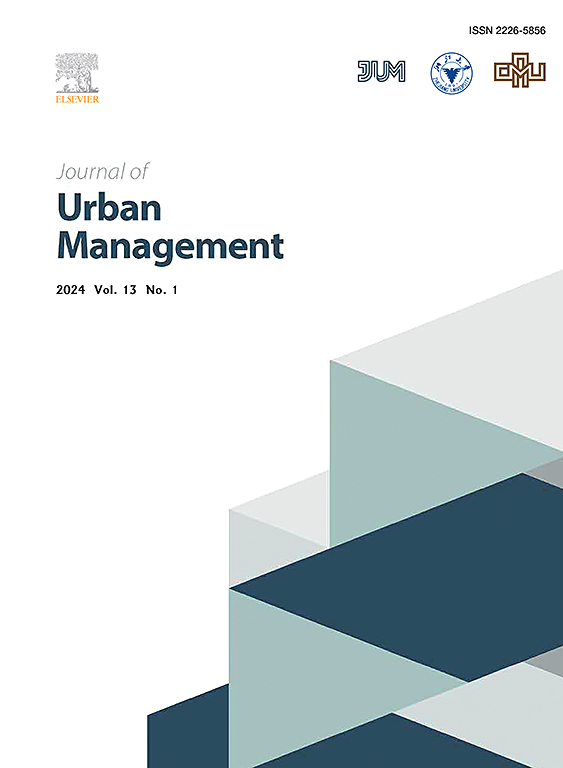人们如何看待城市交通服务质量?上海地铁系统在线评论的新启示
IF 5
2区 社会学
Q1 URBAN STUDIES
引用次数: 0
摘要
快速的城市化和对高效公共交通日益增长的需求凸显了了解公众对服务质量看法的必要性。传统的评估方法可能无法完全捕捉到用户的体验和感知,而新兴的大规模社交媒体数据则提供了动态的用户生成信息,为我们提供了新的见解。针对这一问题,本研究基于大众点评网的用户生成内容,采用数据驱动方法探讨了上海地铁系统的服务质量感知。我们采用结构主题模型(STM)分析了 52,087 条在线评论,以确定关键服务质量属性及其对用户满意度的影响。我们的研究结果揭示了 11 个重要主题:自我表达"、"换乘"、"便利设施"、"购物中心"、"办理登机手续"、"运营"、"安全检查"、"工作人员"、"环境与设施"、"设计 "和 "高峰与通勤"。极性分析表明,"自我表达"、"签到 "和 "设计 "被认为是正面的,而 "安检"、"通勤 "和 "换乘 "则被认为是负面的。话题的时间动态变化表明,与交通服务的物理环境相比,用户更优先关注审美和态度。此外,分层聚类显示了不同的空间模式,住宅区车站强调通勤和出行需求,商业区车站关注设计和运营方面,而其他车站则强调清洁和安全问题。这些发现为加强城市交通管理提供了实用的见解,使提供的服务更符合用户的偏好,并改善城市的可持续发展。本文章由计算机程序翻译,如有差异,请以英文原文为准。
How do people perceive the quality of urban transport service? New insights from online reviews of Shanghai metro system
Rapid urbanization and increasing demand for efficient public transportation have highlighted the need to understand public perceptions of service quality. Traditional evaluation methods may not fully capture user experiences and perceptions, and the emerging large-scale social media data offers dynamic user-generated information for new insights. To address this, this study explored the perceived service quality of the Shanghai metro system using a data-driven approach based on user-generated content from Dianping.com. We analyzed 52,087 online reviews by employing the structural topic model (STM) to identify key service quality attributes and their impact on user satisfaction. Our findings reveal eleven significant topics: 'Self-expression', 'Transfer', 'Amenity', 'Shopping Mall', 'Check-in', 'Operation', 'Security Check', 'Staff', 'Environment & Facility', 'Design', and 'Peak & Commuting'. Polarity analysis indicates that 'Self-expression', 'Check-in', and 'Design' are viewed positively, while 'Security check', 'Commuting', and 'Transfer' are perceived negatively. Temporal dynamics of topics demonstrated that the users prioritized and focused more on aesthetic and attitude than the physical environment of transport services. Furthermore, hierarchical clustering reveals distinct spatial patterns, with stations in residential areas emphasizing commuting and travel needs, business district stations focusing on design and operational aspects, and other stations highlighting cleanliness and security concerns. These findings provide practical insights into enhancing urban transport management by aligning service offerings more closely with user preferences and improving sustainable urban development.
求助全文
通过发布文献求助,成功后即可免费获取论文全文。
去求助
来源期刊

Journal of Urban Management
URBAN STUDIES-
CiteScore
9.50
自引率
4.90%
发文量
45
审稿时长
65 days
期刊介绍:
Journal of Urban Management (JUM) is the Official Journal of Zhejiang University and the Chinese Association of Urban Management, an international, peer-reviewed open access journal covering planning, administering, regulating, and governing urban complexity.
JUM has its two-fold aims set to integrate the studies across fields in urban planning and management, as well as to provide a more holistic perspective on problem solving.
1) Explore innovative management skills for taming thorny problems that arise with global urbanization
2) Provide a platform to deal with urban affairs whose solutions must be looked at from an interdisciplinary perspective.
 求助内容:
求助内容: 应助结果提醒方式:
应助结果提醒方式:


